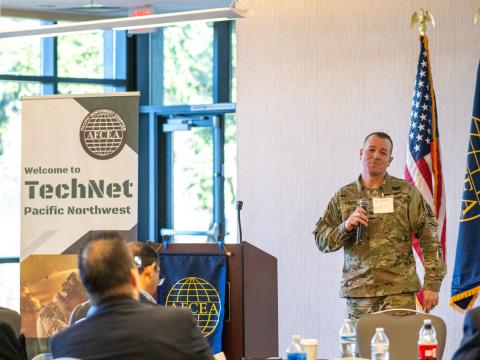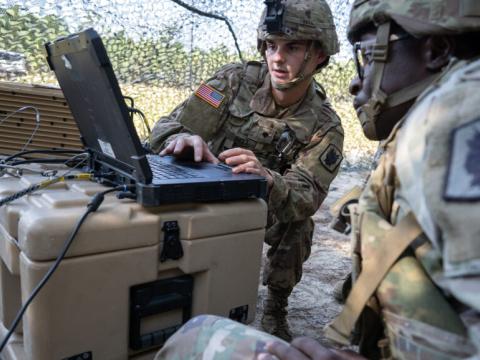Atmospheric Radio May Save Satellite Bandwidth
 |
| The Dual-Mode, All-Band Relocatable Tactical Terminal (DART-T) combines both troposcatter and satellite communications (SATCOM) capabilities. It can transmit data and video signals at faster speeds than legacy troposcatter systems and uses technologies borrowed from the SATCOM industry to deploy its antenna automatically and to acquire a signal. |
With a flip of a switch, a new tactical communications terminal enables warfighters to choose between troposcatter and satellite communications. This technology could reduce the demand on heavily saturated satellite bandwidth through its use of over-the-horizon radio transmissions to carry voice, data and real-time video imagery.
The
Hegarty notes that the standard troposcatter communications system used by the
Hegarty describes DART-T as a family of equipment that is fundamentally a satellite communications terminal. Its core is the terminal and antenna of the Joint Network Node (JNN) Satellite Transportable Terminal (STT), but the feeds were changed, and two different high-power amplifiers (HPAs), a processor stack and additional electronics were added. All of these new components fit inside the STT’s middle equipment bay. He adds that modifying the STT to transmit via troposcatter makes more sense than creating a new set of terminals. “If you look at the cost of bandwidth, the tropo modification kit pays for itself very quickly, and it gives you a lot more bandwidth than you’re getting off a satellite,” he maintains.
The terminal is controlled from a laptop. Operators can select either troposcatter or satellite communications, and the DART-T system will automatically choose the appropriate modem for the transmission. “When you bring the terminal controller up [on screen], there are two windows. One says SATCOM [satellite communications]; the other says tropo, and you just click on the one you want,” he explains.
Raytheon has been developing the DART-T prototype for about a year. Hegarty says that the challenge has been to change the military communications community’s mindset that troposcatter systems are large, higher echelon systems. “We want to move high-bandwidth data, and we think that’s the essence of being network centric,” he states.
DART-T also offers a variety of advantages over legacy troposcatter systems such as the AN/TRC-170, which is widely used by the
TRC-170 systems can transmit up to three T-1 lines worth of data. But these lines are fixed, whether the bandwidth is being used or not, Hegarty says. In contrast, DART-T can change how much bandwidth it uses. “You can’t adapt to that [fixed bandwidth]. In our scenario, if the weather conditions are better, or if you get a good link, the system will automatically crank up the bandwidth so that you can pass additional traffic. And you need to do that [alter bandwidth to move data packets] in the IP [Internet protocol] world. In a mesh network, if you have a problem with a link, it allows you to keep moving that traffic. We wanted to go from legacy baseband hardware to IP centric and being able to move large amounts of traffic, full-motion video, data,” he says.
An additional advantage troposcatter communications has over satellite uplinks is a lack of latency, the delay in communication as radio waves travel hundreds or thousands of miles across satellite links. Satellite communications has latency in the range of 600 milliseconds per link, but Hegarty maintains that troposcatter systems do not exhibit any latency. Latency is a major constraint for full-motion video and other real-time data applications.
DART-T evolved out of two U.S. Air Force programs. The first was an Air Force concept study for a new-generation troposcatter system. The program was called Over The Horizon (OTH), and its requirements called for a single-antenna, 20-megabyte, Ku-band troposcatter capability. Hegarty notes that no troposcatter systems had ever operated in the Ku band before because it was assumed that the signal would experience higher atmospheric attenuation at that frequency. But Air Force studies indicated that Ku was a viable bandwidth because the scattering used by troposcatter technology is enhanced by weather conditions such as storm clouds. However, Ku-band satellite terminals can lose their links in bad weather.
 |
| DART-T is designed to fit on a variety of platforms, from vehicles to trailers to air-transportable pallets. Unlike legacy troposcatter systems, which are large systems designed to serve upper echelons, DART-T can be rapidly deployed and remotely operated. |
Operating in the Ku band offers further benefits. Legacy troposcatter systems operate in a diversity mode, which uses four receivers. These receivers must obtain data from different paths, which requires most systems to have two large antennas. Raytheon’s engineers have condensed this capability. DART-T has a feature called angle diversity feed, which permits two beams to transmit from one reflector. “This allows you to be much more mobile, and it gives you the same performance as two antennas. And with two transmitters, you get the quad diversity that you wouldn’t have had before unless you had this very complicated Erector set of multiple antennas,” he says.
Hegarty shares that all of DART-T’s advances are evolutionary changes that TRC-170 users have desired for years. He notes that one major complaint from troposcatter operators is antenna alignment. “It’s not like you’re peaking on a radio carrier-wave signal. It’s fading all the time; you’re trying to adjust the antenna to peak on it; and you never really know if you have it correctly peaked,” he says.
To solve this dilemma, Raytheon developed a proprietary algorithm that allows the system to acquire a troposcatter signal automatically in the same way radios acquire nonfading satellite beacons. “We’re bringing all this into a realm where if you’re an operator of a SATCOM terminal, there’s no reason you can’t operate this tropo terminal. It’s fundamentally the same thing,” Hegarty explains.
Because the automated DART-T can be controlled by a laptop, it can be set up in about 10 minutes and operated remotely. Operators on the other side of a communications link can monitor the terminal, and IP-addressed video cameras can be established in a perimeter to provide security. “You could have a network control facility at any location around the world that could be monitoring these terminals. It has full control of every assembly, the upconverters, the downconverters, the HPAs. You can troubleshoot them. You can turn them on and off and do diagnostics. You can do all of that remotely,” he offers.
DART-T can be mounted on a pallet placed in the back of a high-mobility multipurpose wheeled vehicle or on a trailer, or it can be moved on an air-transportable flyaway pallet. The system is available in a variety of configurations. “It depends on the mission you want. But for most tactical missions, you can use a single 2.4-meter antenna. If you’ve got some high-bandwidth, long-range, fixed shots, then we would go with bigger antennas and bigger HPAs, but we’d still use the common middle IF [intermediate frequency] equipment,” Hegarty states.
Raytheon currently is completing its proprietary software for DART-T antenna acquisition, adaptive bandwidth and mission planning. The company has demonstrated the system, and Hegarty says that additional demonstrations are planned with a number of U.S. Defense Department customers. He explains that the terminal is proving popular with the services, but the challenge is that no program of record currently exists to procure it.
In December 2006, the I Marine Expeditionary Force (MEF) in
The demonstration at
Col. Bruno notes that what makes DART-T attractive is that it is a multiband and multicapable system that can operate in both satellite and troposcatter modes at data rates of up to 40 megabytes per second, which is much faster than the service’s legacy TRC-170 systems.
The December exercise demonstrated that DART-T had all of the capabilities the Marine Corps desires. “With a flip of a switch, it can go either tropo or SATCOM, which really provides us a lot of flexibility and additional capability while reducing our footprint forward. I no longer have to bring two different systems, and I no longer have to train Marines to operate both tropo and SATCOM. I just train one Marine to operate one system,” Col. Bruno explains.
The colonel adds that with the possible exception of a few units, the Marine Corps does not intend to purchase DART-T as is but instead might incorporate the technology into its secure wide area network (SWAN) terminals. He says that the Corps would like to have the same troposcatter/satellite communications capability in the SWAN system that the Army enjoys in the JNN.
DART-T’s flexibility also is attractive to the Marine Corps as the system can be transported in different ways. Because it uses an automatic clamshell antenna and tracking system, it can be set up and operational within minutes, he notes. “Anything that’s smaller and quicker to operate is useful, especially in expeditionary operations. It would have been great in Operation Iraqi Freedom as we were going north into
Web Resource
Raytheon Company: www.raytheon.com




Comments